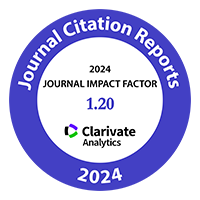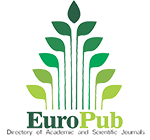Impact of intra-vineyard soil heterogeneity on Malbec. Vine growth, yield and wine elemental composition and sensory profile
DOI:
https://doi.org/10.48162/rev.39.147Palabras clave:
perfil catiónico, variabilidad edáfica, propiedades organolépticas del vino, expresión fenotípica, tipo de suelo, terruñoResumen

In Mendoza, viticulture is increasingly expanding into mountainous regions, taking advantage of cooler temperatures. High-altitude vineyards, characterized by greater soil heterogeneity, can significantly impact grapevine growth, development, elemental uptake, and wine sensory attributes. Despite its relevance, the effects of intra-vineyard variability on wine organoleptic quality and elemental composition remain underexplored in the existing literature. This study investigated a high-altitude vineyard planted with Vitis vinifera L. cv. "Malbec", focusing on two contrasting soil depth profiles: shallow soil (SS) and deep soil (DS). The DS exhibited a finer texture, higher water retention and greater cation exchange capacity than the SS. Additionally, DS contained higher concentrations of Mn, while SS was richer in Ca. Vegetative growth and yield varied according to soil type and vintage. Wines from DS showed higher [Mn], consistent with the soil, and increased [Fe] and [Cu] compared to SS wines, possibly due to indirect effects. Significant differences were observed in wine organoleptic properties, with SS wines exhibiting greater color intensity, astringency, and structure. Certain aromas, such as cherry and plum were negatively correlated with [Mn]. These findings highlight the influence of vineyard soils on the elemental composition and sensory profiles of wines, providing valuable insights into terroir characteristics for management strategies.
Highlights:
- Intra-vineyard soil heterogeneity significantly affects vegetative growth, elemental composition, and the sensory profile of Malbec wine.
- Vines in deep soils exhibited greater vigor and produced more clusters per plant than those in shallow soils.
- Deep soils retain more water, have higher clay and silt content, and produce wines with higher Mn. In contrast, shallow soils are sandier and rockier, with lower water retention, leading to wines with greater color intensity, astringency, and structure.
Descargas
Citas
Abdi, H.; Williams, L. J.; Valentin, D. 2013. Multiple factor analysis: Principal component analysis for multitable and multiblock data sets. Wiley Interdisciplinary Reviews: Computational Statistics. 5(2): 149-179. https://doi.org/10.1002/wics.1246
Almeida, C.; Vasconcelos, M. 2003. Multielement composition of wines and their precursors including provenance soil and their potentialities as fingerprints of wine origin. Journal of Agricultural and Food Chemistry. 51(16): 4788-4798. https://doi: 10.1021/jf034145b
Arias, L. A.; Berli, F.; Fontana, A.; Bottini, R.; Piccoli, P. 2022 Climate change effects on grapevine physiology and biochemistry: Benefits and challenges of high altitude as an adaptation strategy. Frontiers in Plant Science. 13: 835425. https://doi: 10.3389/fpls.2022.835425
Attia, F.; Garcia, F.; Ben Mariem, F.; Nuzzo, V.; Dedieu, F.; Garcia, M.; Lamaze, T. 2010. Water stress in Tannat and Duras grapevine cultivars (Vitis vinifera L.): Leaf photosynthesis and grape phenolic maturity. Journal International des Sciences de la Vigne et du Vin. 6: 81-93.
Ayamba B. E.; Abaidoo R. C.; Opoku A.; Ewusi-Mensah N. 2023. Mechanisms for nutrient interactions from organic amendments and mineral fertilizer inputs under cropping systems: A review. PeerJ. 11: e15135. https://doi:10.7717/peerj.15135
Baggiolini M. 1952. Les stades repères dans le développement annuel de la vigne et leur utilisation pratique. Revue romande d’Agriculture et d’Arboriculture. 8(1): 4-6.
Berli, F.; D’Angelo, J.; Cavagnaro, B.; Bottini, R.; Wuilloud, R.; Silva, M. F. 2008 Phenolic composition in grape (Vitis vinifera L. cv. Malbec) ripened with different solar UV-B radiation levels by capillary zone electrophoresis. Journal of Agricultural and Food Chemistry. 56: 2892-2898. https://doi: 10.1021/jf073421+
Berli, F.; Alonso, R.; Beltrano, J.; Bottini, R. 2015. High altitude solar UV-B and abscisic acid sprays increase grape berry antioxidant capacity. American Journal of Enology and Viticulture. 66(1): 65-72. https://doi.org/10.5344/ajev.2014.14067
Boulton, R. 1999. El fenómeno de la copigmentación en los vinos tintos. Actas Seminario Internacional “Hacia la Enología del siglo XXI”. INTA, Facultad de Ciencias Agrarias. Universidad Nacional de Cuyo. Argentina.
Bouyoucos, G. J. 1951. A recalibration of the hydrometer method for making mechanical analysis of soils. Agronomy Journal. 43(9): 434-438.
Bramley, R. G. V.; Hamilton, R. P. 2007. Terroir and precision viticulture: are they compatible? Journal International des Sciences de la Vigne et du Vin. 41: 1-8. https://doi.org/10.20870/oenoone.2007.41.1.855
Bramley, R.; Ouzman, J.; Boss, P. 2011. Variation in vine vigour, grape yield and vineyard soils and topography as an indicator of variation in the chemical composition of grapes, wine and wine sensory attributes. Australian Journal of Grape and Wine Research. 17(2): 217-229. https://doi.org/10.1111/j.1755-0238.2011.00136.x
Bravo, S.; Amoros, J. A.; Perez-De-Los-Reyes, C.; García, F. J.; Moreno, M. M.; Sanchez-Ormeno, M.; Higueras, P. 2017. Influence of the soil pH in the uptake and bioaccumulation of heavy metals (Fe, Zn, Cu, Pb and Mn) and other elements (Ca, K, Al, Sr and Ba) in vine leaves. Castilla-La Mancha (Spain). Journal of Geochemical Exploration. 174: 79-83. https://doi.org/10.1016/j.gexplo.2015.12.012
Bruand, A.; Duval, O.; Cousin, I. 2004. Estimation des propriétés de rétention en eau des sols à partir de la base de données SOLHYDRO: Une première proposition combinant le type d’horizon, sa texture et sa densité apparente. Étude et gestion des Sols. 11(3): 3-323.
Campbell, L. C.; Nable, R. O. 1988. Physiological functions of manganese in plants. In: Graham, R. D.; Hannam, R. J.; Uren N. C. (Eds.). Manganese in soils and plants. Kluwer Academic Publishers: Dordrecht. 139-154. https://doi.org/10.1007/978-94-009-2817-611
Caravaca, F.; Lax, A.; Albaladejo, J. 1999. Organic matter, nutrient contents and cation exchange capacity in fine fractions from semiarid calcareous soils. Geoderma. 93: 161-176. https://doi.org/10.1016/S0016-7061(99)00045-2
Carrillo, N.; Piccoli, P.; Bottini, R.; Rodríguez, J.; Berli, F. 2020. Girdling of shoots at flowering reduces shatter in grapevine cv. Malbec. Australian Journal of Grape and Wine Research. 26(2): 102-109. https://doi.org/10.1111/ajgw.12423
Catania, C. D.; Avagnina, S. 2010. La interpretación sensorial del vino. In: El terruño argentino. INTA y Editora Andina Sur.
Chapman, D. M.; Roby, G.; Ebeler, S. E.; Guinard, J. X.; Matthews, M. A. 2005. Sensory attributes of Cabernet Sauvignon wines made from vines with different water status. Australian Journal of Grape and Wine Research. 11(3): 339-347. https://doi:10.1111/j.1755-0238.2005.tb00033.x
Chavez, D. 2013. Groundwater potential of pampa aquifers in two glacial watersheds, Cordillera Blanca, Peru. Master Science Thesis. McGill University, Montreal. Quebec. Canada. 69 p.
Corona, G. 2019. La geografía del vino. In: Malher, P. (Ed.). Ciudad Autónoma de Buenos Aires. Argentina.
de Freitas, V. A. P.; Fernandes, A.; Oliveira, J.; Teixeira, N.; Mateus, N. 2017. A review of the current knowledge of red wine colour. OENO One. 51: 1. https://doi.org/10.20870/oenoone.2017.51.1.1604
Di Rienzo, J. A.; Casanoves, F.; Balzarini, M. G.; González, L.; Tablada, M.; Robledo, C. W. 2018. InfoStat (versión 2018) [Software]. Universidad Nacional de Córdoba, Argentina. http://www.infostat.com.ar
Funes Pinter, I.; Salomon, M. V.; Gil, R.; Mastrantonio, L.; Bottini, R.; Piccoli, P. 2018. Arsenic and trace elements in soil, water, grapevine and onion in Jachal, Argentina. Science of the Total Environment. 615: 1485-1498. https://doi.org/10.1016/j.scitotenv.2017.09.114
Galani-Nikolakaki, S.; Kallithrakas-Kontos, N.; Katsanos, A. A. 2002. Trace element analysis of Cretan wines and wine products. Science of the Total Environment. 285(1-3): 155-163. https://doi:10.1016/S0048-9697(01)00912-3
Guilpart, N.; Metay, A.; Gary, C. 2014. Grapevine bud fertility and number of berries per bunch are determined by water and nitrogen stress around flowering in the previous year. European Journal of Agronomy. 54: 9-20. https://doi.org/10.1016/j.eja.2013.11.002
Heymann, H.; Hopfer, H.; Bershaw, D. 2014. An exploration of the perception of minerality in white wines by projective mapping and descriptive analysis. Journal of Sensory Studies. 29(1): 1-13. https://doi:10.1111/joss.12076
Hidalgo, J. 2006. La calidad del vino desde el viñedo. In: Ediciones Mundi-Prensa. Madrid.
Hilbert, G.; Soyer, J. P.; Molot, C.; Giraudon, J.; Milin, S.; Gaudillere, J. P. 2003. Effects of nitrogen supply on must quality and anthocyanin accumulation in berries of cv. Merlot. Vitis. 42(2): 69-76. https://doi.org/10.5073/vitis.2003.42.69-76
INV. 2023. Informe anual de superficie 2023. https://www.argentina.gob.ar/inv/vinos/estadisticas/superficie/anuarios
Kabata-Pendias, A. 2011. Trace elements of soils and plants. In: CRC Press, Taylor & Francis Group.
Kment, P.; Mihaljevič, M.; Ettler, V.; Šebek, O.; Strnad, L.; Rohlová, L. 2005. Differentiation of Czech wines using multi element composition - A comparison with vineyard soil. Food Chemistry. 91(1): 157-165. https://doi:10.1016/j.foodchem.2004.06.010
Lawless, H. T.; Heymann, H. 2010. Sensory evaluation of food - principles and practices. In: Sensory Evaluation of Food-Principles and Practices. p. 473-478.
Lê, S.; Josse, J.; Husson, F. 2008. FactoMineR: An R Package for Multivariate Analysis. Journal of Statistical Software. 25(1): 1-18. https://doi.org/10.18637/jss.v025.i01
Maltman, A. 2008. The role of vineyard geology in wine typicity. Journal of Wine Research. 19(1): 1-17. https://doi:10.1080/09571260802163998
Maltman, A. 2013. Mineral taste in wine, minerals in the vineyard are they connected? Wines and Vines. 94(5): 63.
Malvi, U. R. 2011. Interaction of micronutrients with major nutrients with special reference to potassium. Karnataka Journal of Agricultural Sciences. 24(1): 106-109.
Mantilla, S. M. O.; Collins, C.; Iland, P. G.; Kidman, C. M.; Ristic, R.; Boss, P. K.; Jordans, C.; Bastian, S. E. 2018. Shiraz (Vitis vinifera L.) berry and wine sensory profiles and composition are modulated by rootstocks. American Journal of Enology and Viticulture. 69(1): 32-44. https://doi: 10.5344/ajev.2017.17017
Marengo, E.; Aceto, M. 2003. Statistical investigation of the differences in the distribution of metals in Nebbiolo-based wines. Food Chemistry. 81(4): 621-630. https://doi:10.1016/S0308-8146(02)00564-2
McDonald, M. S.; Hughes, M.; Burns, J.; Lean, M. E. J.; Matthews, D.; Crozier, A. 1998. Survey of the free and conjugated myricetin and quercetin content of red wines of different geographical origins. Journal of Agricultural and Food Chemistry. 46(2): 368-375. https://doi:10.1021/jf970677e
Mezzatesta, D. S.; Berli, F.; Arancibia, C.; Buscema, F.; Piccoli, P. 2022. Impact of contrasting soils in a high-altitude vineyard of Vitis vinifera L. cv. Malbec: root morphology and distribution, vegetative and reproductive expressions, and berry skin phenolics. OENO One. 56(2): 149-163. https://doi.org/10.20870/oeno-one.2022.56.2.4917
Monteiro, A.; Malheiro A.; Bacelar, E. (2021). Morphology, physiology and analysis techniques of grapevine bud fruitfulness: A Review. Agriculture. 11(2): 127. https://doi.org/10.3390/agriculture11020127
Mousavi, S. R.; Shahsavari, M.; Rezaei, M. 2011. A general overview on manganese (Mn) importance for crop production. Australian Journal of Basic and Applied Sciences. 5(9): 1799-1803.
Noble, A. C.; Arnold, R. A.; Buechsenstein, J.; Leach, E. J.; Schmidt, J. O.; Stern, P. M. 1987. Modification of a standardized system of wine aroma terminology. American Journal of Enology and Viticulture. 38(2): 143-146.
Ojeda, H. 2000. Los compuestos polifenólicos de la uva. In: EEA Mendoza. INTA.
Oliveira, C.; Ferreira, A. C.; Costa, P.; Guerra, J.; Guedes de Pinho, P. 2004. Effect of some viticultural parameters on the grape carotenoid profile. Journal of Agricultural and Food Chemistry. 52: 4178-4184. https://doi: 10.1021/jf0498766
Pirie, A.; Mullins, M. G. 1976. Changes in anthocyanin and phenolics content of grapevine leaf and fruit tissues treated with sucrose, nitrate, and abscisic acid. Plant Physiology. 58: 468-472.https://doi.org/10.1104/pp.58.4.468
QGIS Development Team. 2020. QGIS Geographic Information System. Open Source Geospatial Foundation. https://qgis.org
Richards, L. A. 1954. Diagnosis and improvement of saline and alkali soils. United States Salinity Laboratory Staff. Agriculture 160. Handbook 60. https://www.ars.usda.gov/ARSUserFiles/20360500/hb60_pdf/hb60complete.pdf
Roig-Puscama, F.; Berli, F.; Roig, F. A.; Tomazello-Filho, M.; Mastrantonio, L.; Piccoli, P. 2021. Wood hydrosystem of three cultivars of Vitis vinifera L. is modified in response to contrasting soils. Plant and Soil. 463: 573-588. https://doi.org/10.1007/s11104-021-04907-y
Scholander, P. F.; Hammel, H. T.; Bradstreet, E. D.; Hemmingsen, E. A. 1965. Sap pressure in vascular plants. Science. 148(3668): 339-346. https://doi.org/10.1126/science.148.3668.339
Silva-Contreras, C.; Sellés-Von Schouwen, G.; Ferreyra-Espada, R.; Silva-Robledo, H. 2012. Variation of water potential and trunk diameter answer as sensitivity to the water availability in table grapes. Chilean Journal of Agricultural Research. 72(4): 459-469. https://doi:10.4067/S0718-58392012000400001
Srinivasan, C.; Mullins, M. G. 1981. Physiology of flowering in the grapevine-a review. American Journal of Enology and Viticulture. 11(1): 47-63. https://doi.org/10.5344/ajev.1981.32.1.47
Stockley, C. S.; Høj, P. B. 2005. Better wine for better health: Fact or fiction? Australian Journal of Grape and Wine Research. 11(2): 127-138. https://doi.org/10.1111/j.1755-0238.2005.tb00284.x
Tariba, B. 2011. Metals in wine-Impact on wine quality and health outcomes. Biological Trace Element Research. 144(1-3): 143-156. https://doi:10.1007/s12011-011-9052-7
Tomasi, N.; Monte, R.; Varanini, Z.; Cesco, S.; Pinton, R. 2015. Induction of nitrate uptake in Sauvignon Blanc and Chardonnay grapevines depends on the scion and is affected by the rootstock. Australian Journal of Grape and Wine Research. 21(2): 331-338. https://doi.org/10.1111/ajgw.12137
Tominaga, T.; Guimbertau, G.; Dubourdieu, D. 2003. Contribution of benzenemethanethiol to smoky aroma of certain Vitis vinifera L. wines. Journal of Agricultural and Food Chemistry. 51(5): 1373-1376. https://doi:10.1021/jf020756c
van Leeuwen C. 2010. Terroir: the effect of the physical environment on vine growth, grape ripening and wine sensory attributes. In: Reynolds A. (Ed.). Managing wine quality. Woodhead publishing series in food science, technology and nutrition, p. 273-315. http://dx.doi.org/10.1533/9781845699284.3.273
van Leeuwen, C.; Friant, P.; Choné, X.; Tregoat, O.; Koundouras, S.; Dubourdieu, D. 2004. Influence of climate, soil, and cultivar on terroir. American Journal of Enology and Viticulture. 55: 207-217. https://doi.org/10.5344/ajev.2004.55.3.207
van Leeuwen, C.; Seguin, G. 2006. The concept of terroir in viticulture. Journal of Wine Research. 17: 1-10. https://doi.org/10.1080/09571260600633135
van Leeuwen, C.; Tregoat, O.; Choné, X.; Bois, B.; Pernet, D.; Gaudillère, J. P. 2009. Vine water status is a key factor in grape ripening and vintage quality for red Bordeaux wine. How can it be assessed for vineyard management purposes? Journal International des Sciences de la Vigne et du Vin. 43: 121-134. https://doi.org/10.20870/oeno-one.2009.43.3.798
White, P. J.; Broadley, M. R. 2003. Calcium in plants. Annals of Botany. 92(4): 487-511. https://doi.
org/10.1093/aob/mcg164

Descargas
Publicado
Cómo citar
Número
Sección
Licencia
Derechos de autor 2018 Revista de la Facultad de Ciencias Agrarias UNCuyo

Esta obra está bajo una licencia internacional Creative Commons Reconocimiento-NoComercial-CompartirIgual 3.0.
Aquellos autores/as que tengan publicaciones con esta revista, aceptan las Políticas Editoriales.












.jpg)




